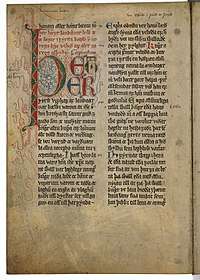Magnus Lagabøtes landslov
Magnus Lababötes landslov ("Magnus Lagabøte's State Law") was a law covering the whole of Norway, issued by King Magnus VI of Norway between 1274 and 1276. The law was the first to apply to Norway as a whole and is one of the first examples of comprehensive national legislation from a central authority in Europe. The law is the reason that the king was given the name Lagabøte, "the one who improves the law".

Although the legislation applied to the whole country, it formally consisted of four different law books, one for each of the four jurisdictions (Gulating, Frostating, Eidsivating and Borgarting). However, the content of the four statutes was largely similar and was based primarily on the previous jurisdictional laws. In addition, a separate City Law, Magnus Lagabøtes bylov, was issued for the cities, from 1276.
The preparation of a shared law strengthened the central authorities and the king's power. This led to reactions, especially from the Church. Archbishop Jon Raude in Nidaros opposed the king intervening in the ecclesiastical sphere and revising ecclesiastical legislation. There was a prolonged tug of war between the king on the one hand and the church on the other side, which ended with a settlement and a compromise, called the Sættargjerden, in Tønsberg in 1277. The archbishop succeeded in securing the church a considerable tax deduction and greater legal privileges.
Large sections of the legislation were applicable for more than 400 years. It was revised and translated into Danish in 1604 and received the name Christian IVs Norsk Lov ("Christian IV's Norwegian Law"), named after King Christian IV of Denmark. In 1687 the legislation was repealed and replaced by Christian Vs Norsk Lov.
There were at least 41 copies or manuscript of the State Law in circulation and it was the most widely used non-religious book in medieval Norway. There were large and small differences in the wording between the manuscripts, and this variation was known by those who used the manuscripts, as shown in the form of notes in the margins. According to Jørn Øyrehagen Sunde, the wording was not followed slavishly, and adapted to each individual case.[1]
See also
References
- Jørn Øyrehagen Sunde, 'Stordomen til Landslova', Dag og Tid, 15. January 2016.
Sources
- «Magnus Lagabøtes landslov», Store norske leksikon
- «Magnus Lagabøtes landslov», at Norgeshistorie.no
- «Forbrytelse og straff», at Norgeshistorie.no